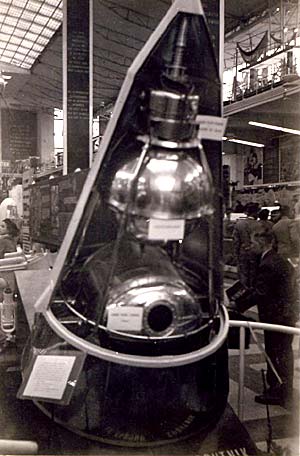Changes
19th January 2012 Minor amendments. In October 1957, Sputnik was launched by the Soviets.
Both America and Russia said that they would launch satellites for the International Geophysical Year (1957-8) but this was taken as "a pinch of salt" by the general public.
In May - August 1957 the Soviets published simple communications receiver details to enable Radio Amateurs "to listen for an artificial moon which would broadcast on wavelengths of 7.5 and 15 metres". This was the 20MHz & 40MHz Amateur Bands - a very clever move. This was not generally know in the West at that time.
In June 1957 Prof Alexander Nesmeyanov, Presidentof the Soviet Academy of Sciences said that it was realistic to be able to reach the Moon and provide an artificial earth Satellite.
As reported in CARS October Newsletter a number of CARS Members heard the Sputnik (Sputnik is a Russian word for "satellite" but is often translated as "traveller") and a few actually saw it flashing in the sky. We now know that this was reflectors put out of the casing of the R-7 rocket which trailed the satellite 600 miles behind - but who cares! It is now estimated 4% of Americans saw this - it caused great consternation in the media although it was publicly dismissed by the Administration.

Copy of Sputnik at the Brussels Exhibition, 1958
Under the spherical top satellite is the later satellite which shot the first dog into space.
Photo by Carl, G3PEM taken in 1958Sergei Korolev could be justly proud of his acheivement - the Soviet military where only interested in the fact that it was a modified ICBM! Sergei insisted in having two TX on different frequencies incase one failed and also to check the different propagation effects from space. We now know that the simple Bleep-Bleep-Bleep did contain data which sent back the temperature inside the satellite by varying the length of the Bleep and the pause between the next Bleep.
It took Sputnik 96 minutes to circle the world - this was brought home recently when a Scout from Hylands Park, using GB100J, asked the International Space Station "What was it like to see a sunrise?" The answer came back from space "Great. I see 16 every day!"
It lasted for 21 days before its batteries ran out.
Various Sputnik related links compiled by Eric W3DQ:
AUDIO ITEMS ON SPUTNIK FROM NATIONAL PUBLIC RADIO:
Weekend Edition Sunday (Sept 30, 2007)
Space Race Permeated Pop Culture
http://www.npr.org/templates/story/story.php?storyId=14845436News Analysis: Remembering Sputnik by Daniel Shorr
http://www.npr.org/templates/story/story.php?storyId=14841107Sputnik: The Shock of the Century' Interview with Author Paul Dickson
http://www.npr.org/templates/story/story.php?storyId=14841104All Things Considered (Sept 30, 2007)
Sputnik Left Legacy for U.S. Science Education
http://www.npr.org/templates/story/story.php?storyId=14829195Weekend Edition Saturday (Sept 29, 2007)
Khrushchev, Schorr Look Back on Sputnik
http://www.npr.org/templates/story/story.php?storyId=14829415Talk of the Nation (Sept 28, 2007: 45 min)
Sputnik I, the First Satellite to Orbit Earth, Turns 50
http://www.npr.org/templates/story/story.php?storyId=14799200All Things Considered: (Oct 4, 2002)
Walter Cronkite: How Sputnik Changed the World
http://www.npr.org/templates/story/story.php?storyId=1151147All Things Considered (Oct 4, 1999)
Sputnik Anniversary
http://www.npr.org/templates/story/story.php?storyId=1064887All Things Considered (Oct 1, 1998)
Sputnik Satellite Inspired Congress to Create NASA
http://www.npr.org/templates/story/story.php?storyId=1033054Talk of the Nation (Oct 3, 1997: 1 hr.)
SPUTNIK
http://www.npr.org/templates/story/story.php?storyId=1010850All Things Considered (Oct 4, 1987)
Igor Kripinov: I Remember Sputnik
http://www.npr.org/templates/story/story.php?storyId=4462087SPUTNIK HISTORICAL INFORMATION
Sputnik-1
http://nssdc.gsfc.nasa.gov/database/MasterCatalog?sc=1957-001BSounds of Sputnik
http://nssdc.gsfc.nasa.gov/sound/sputnik.wavFull-scale replica at the National Air & Space Museum
http://www.nasm.si.edu/exhibitions/gal100/sputnikclsup.jpgKorolev, Sputnik, and The International Geophysical Year
http://www.hq.nasa.gov/office/pao/History/sputnik/siddiqi.htmlThrills of the Earliest Days
http://www.svengrahn.pp.se/trackind/getstart/oldcyts.htmGeoff Perry's radio work with his students at the Kettering (UK) School was highlighted in a "NOVA" television documentary, "The Schoolboys Who Cracked The Soviet Secret", which first aired in December 1989. The group continued to operate after Mr. Perry's retirement from teaching in 1984. Perry and his associates published numerous reports in the Journal of the British Interplanetary Society and in US government publications as well.
DID YOU HEAR SPUTNIK?
If so please contact the CARS Editor - see below.
Satellites in use today:
AO-7 - Yes, Oscar 7 is still going after more than 30 years, 70cm to 2m and 2m to 10m linear transponders.
VU-52 - Indian "Mode B" 70cm to 2 metre linear transponder.
AO-51 - FM Only 2m to 70cm and 70cm to 13cm satelliteLots of other beacon/telemetry only satellites.
The AO-10 look-alike called P3E (German) is likely to launch late 2008 and two USA Eagle satellites - also highly eliptical orbits with 70cm-2m linear transponder are scheduled for 2010/11.
A New Zealand satellite and AMSAT-UK linear transponder on an ESA student project are both likely to launch in 2009.
73 Trevor M5AKA
Click here to go back to the TOP of this page.
To RETURN to the Past Events & Sandford Mill Page - Click Here
To RETURN to CARS Home Page - Click Here
ęCopyright CARS 2012